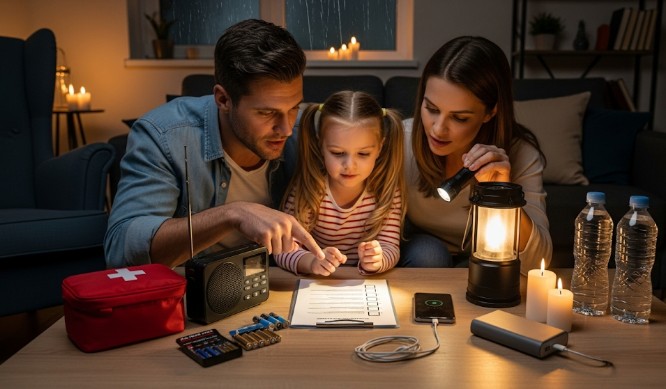Surviving a Blackout: Home Checklist

Objective
Stabilize safety, light, water, comms, and food for a multi-day outage—without creating new hazards.
First 15 Minutes
- Check for hazards (gas smell, sparks, broken glass, stuck elevators). If gas odor: evacuate and call utility from outside.
- Unplug sensitive electronics; leave one light switched on as your “power-return” indicator.
- Stage headlamp, radio, and power bank. Text family status and rendezvous plan.
First Hour
- Water: Fill bathtub/containers now while system pressure lasts.
- Food: Move perishables you’ll eat soon to a cooler with ice packs. Keep fridge/freezer closed.
- Lighting: One lantern per room, placed away from curtains. Prefer LED to candles.
- Security: Lock doors/windows; set door wedge. Recon stairwell with a light if you must leave.
First Night
- Device schedule: rotate charging on the hour to conserve the bank.
- Ventilation: crack a window for fresh air; avoid CO build-up if cooking.
- Comms: get local updates via FM radio; note any boil-water advisories.
Day Two
- Cook fridge/freezer food first using a camp stove outdoors or by an open window with a CO alarm.
- Top up water if pressure remains; check neighbors (especially elderly).
- If outage extends, set a nightly lights-out time and a morning task list.
Apartment Example
8th-floor resident stages a lantern in each room, fills a collapsible 10 L container, wedges the door, and places a battery CO alarm near the kitchen window. A small power bank trickle-charges phones by day at the window from a 10W solar panel.
Common Errors
- Open flames near drapes or on bookshelves.
- Opening the fridge repeatedly “to check.”
- Running a generator indoors or on a balcony.
10-Minute Drill
Flip your main breaker (or simulate). Can you light each room, fill water, and contact family within 10 minutes? Note any gaps and fix them this week.
← Previous | All Articles | Next →
